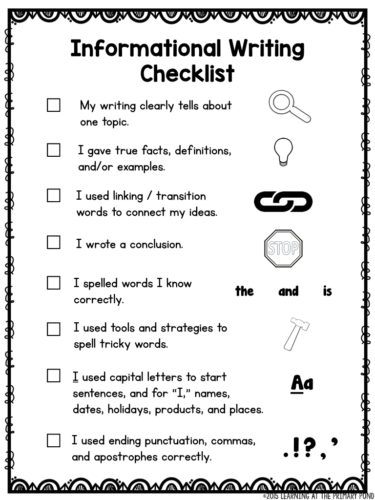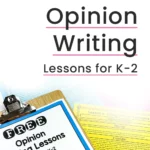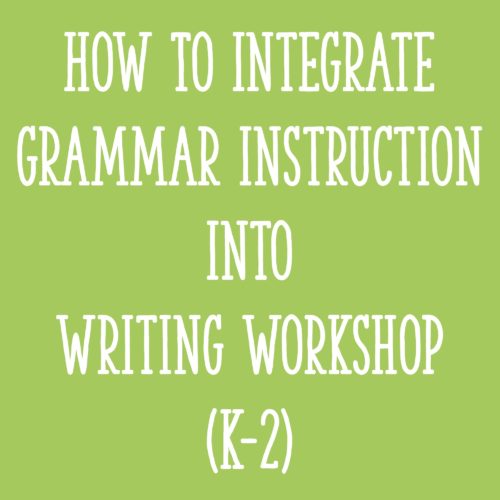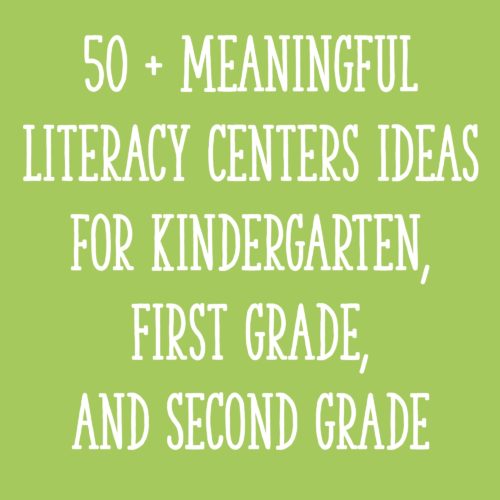You’ve heard the phrase, “less is more,” right? Well, there are definitely situations where that doesn’t apply.
Ice cream is one of those situations ? and another one is students’ writing! I mean, how many times have you said to a student, “Can you add more details?” or “Can you write some more?”
Writing is challenging for many students, and it’s not always easy to get them to produce more (quality) writing.
But it absolutely IS possible! So in this blog post, I’m sharing my favorite strategies for encouraging K-2 students to write more . (And if you’d like to learn more about teaching writing in K-2, check out my free writing webinar after you read this post.)

Photo Credit: racom, Shutterstock
The Problem With Page Number Requirements
When you’re trying to get your students to write more, you may decide to require that they write a certain number of pages or sentences.
But does this actually work?
Well, here’s a story from my own life:
I once had a teacher who refused to give page number requirements. She told us, “Write enough to answer the question.” Some students groaned and tried to weasel a number out of her.
Personally? I loved having that freedom. When I’m given instructions like, “Write a 10+ page paper,” that number is constantly on my mind the whole time I’m writing. I’m always looking to see what page number I’m on and how many more pages I have to write!
On the other hand, my writing comes much more easily when I don’t have to worry about page numbers. I’m freed up to focus on the topic, my ideas, and my organization of the piece – rather than a certain number of pages.
So page number requirements don’t work well for me. But they do work well for some students. (And in some situations, page number requirements are necessary!)
That said, when I’m working with writers in K-2, I almost always avoid requiring them to write a certain number of sentences or pages.
Because here’s what happens if I ask them to write 3 pages:
- 9 kids write rambling stories and repeat themselves over and over, just so that they meet the 3-page requirement.
- 7 kids write 3 pages and then stop, even though they really could have written more!
- 3 kids don’t write anything at all, because they struggle with writing and 3 pages feels way too overwhelming.
- 2 kids happen to write exactly 3 pages, which is what they would have written anyway.
You get the picture. Page number or sentence number requirements can limit some kids, result in poorer writing quality for other kids, and overwhelm certain kids. They’re not a magic solution.
Drawing with Details
So what can we do instead of giving kids page number requirements? Teaching them to draw with details is a great first step!
When kids create a detailed drawing or series of drawings, then they have a starting point to write from. They can write a sentence about each component of the drawing – and that can really add up!
Teaching kids drawing minilessons definitely isn’t a waste of time, because then we can teach kids to write from those details.
Here are a few suggestions for drawing minilessons, as well as how each type of detail can translate into writing:
- Draw to show how you/the characters felt. -> Write about how you/the characters felt.
- Draw to show how people or animals were moving. -> Write about actions (what people/animals did).
- Draw people with multiple body parts and clothing. -> Write to describe what characters look like.
- Draw details in the background. -> Write to describe the setting.
- Draw to show how you feel about a topic. -> Write your opinion about the topic.
- Draw to show the body parts of an animal/plant/other topic. -> Write about what the animal/plant/other topic looks like.
I know that giving kids ample time to draw might seem unproductive. But when we give kids the right instruction and support, that drawing time can help them create longer and more detailed pieces of writing.
We just have to do lots of modeling to show them how to turn drawings into writing.
(And if your students like to spend tons of time drawing and struggle to move onto writing, watch my free writing webinar to help them make this shift.)
Using Checklists
Checklists are a great tool for getting kids to write more!
Of course, we need to spend time teaching our students how to use the checklists. We may even want to have students work as a class to develop a checklist.
But when the checklist is ready, we can have students keep a copy of it in their writing folders throughout a unit. After they finish a piece of writing, they check to make sure that it has all of the items on the checklist. And usually, if we’ve provided them with a really complete checklist, it will be hard for them to meet those requirements without having written a decent amount.
(This checklist is from my revising and editing toolkit.)
Goal Setting
Every year, I explain to my kids that writers improve by writing more. I work with my students to help them set writing goals, and sometimes those goals pertain to how much students write.
One tricky thing about goal setting is that I don’t want to my students to compare themselves to other writers. Something that might be a good goal for one student would be far too easy for another child.
How much a student writes is a very personal goal, in my opinion. I discuss length in a 1:1 setting (or with a small group, if those students tend to write the same amount).
I praise the student for what she has written and then help her set a goal for writing more (adding 2 sentences with more details, or filling up all of the lines on one page).
It really helps if you and the student decide what the additional writing will be about, so she has a clear direction to go in. The more specific, the better.
I then check back in with the student to see how it went, or how I can help her meet the goal moving forward. (That part is important!)
Conclusions
As with so many other aspects of teaching, getting kids to write more is more of an art than a science. We want to encourage and coax rather than force or punish.
In addition to the strategies I mentioned in this post, giving students choice is a big factor in how much they write. If they’re excited about a topic, they’re much more likely to write more about it!
Watch my free online workshop about teaching writing in K-2 to learn more about how I incorporate choice into my writing instruction.
Happy teaching!















What a timely post. Thank you.
So glad it was helpful, Caty!!
Alison
Thank you SO much for this post on teaching student writing, what works and what doesn’t and the why and examples to back both up. It’s really helpful! I teach Kinder and have to admit I’ve been pushing my Kinders to write a certain amount (number of sentences) with a new goal each day (one sentence then two, etc). How do you feel about writing prompts with pictures already there on page (see Simply Kinder’s march writing journal) or if creativity is better practiced with a blank slate. I am learning how to set new goals for each student’s writing… Read more »
Hi Jill! I’m so glad you enjoyed the post! I’ve definitely done the same thing with encouraging my Kinders to write a certain number of sentences…it can be a tough balance sometimes.
I generally allow my students to draw their own pictures, rather than provide them. Drawing is an important part of the writing process for our little ones. That said, sometimes I have my kids talk and write about a picture (great for vocabulary development). This is helpful for integrating science and social studies concepts, too!
I hope this helps! Thank you so much for reading and commenting!
Alison
I’ve been doing this with my second language learners for years! Drawing the details then using those details to write. It definitely helps them in their writing! Thanks for the confirmation of my classroom practice.
That’s awesome, Carolyn! I’m glad to hear it works for your kiddos, too. Thank you so much for reading and commenting!
Alison
This post came in the nick of time.